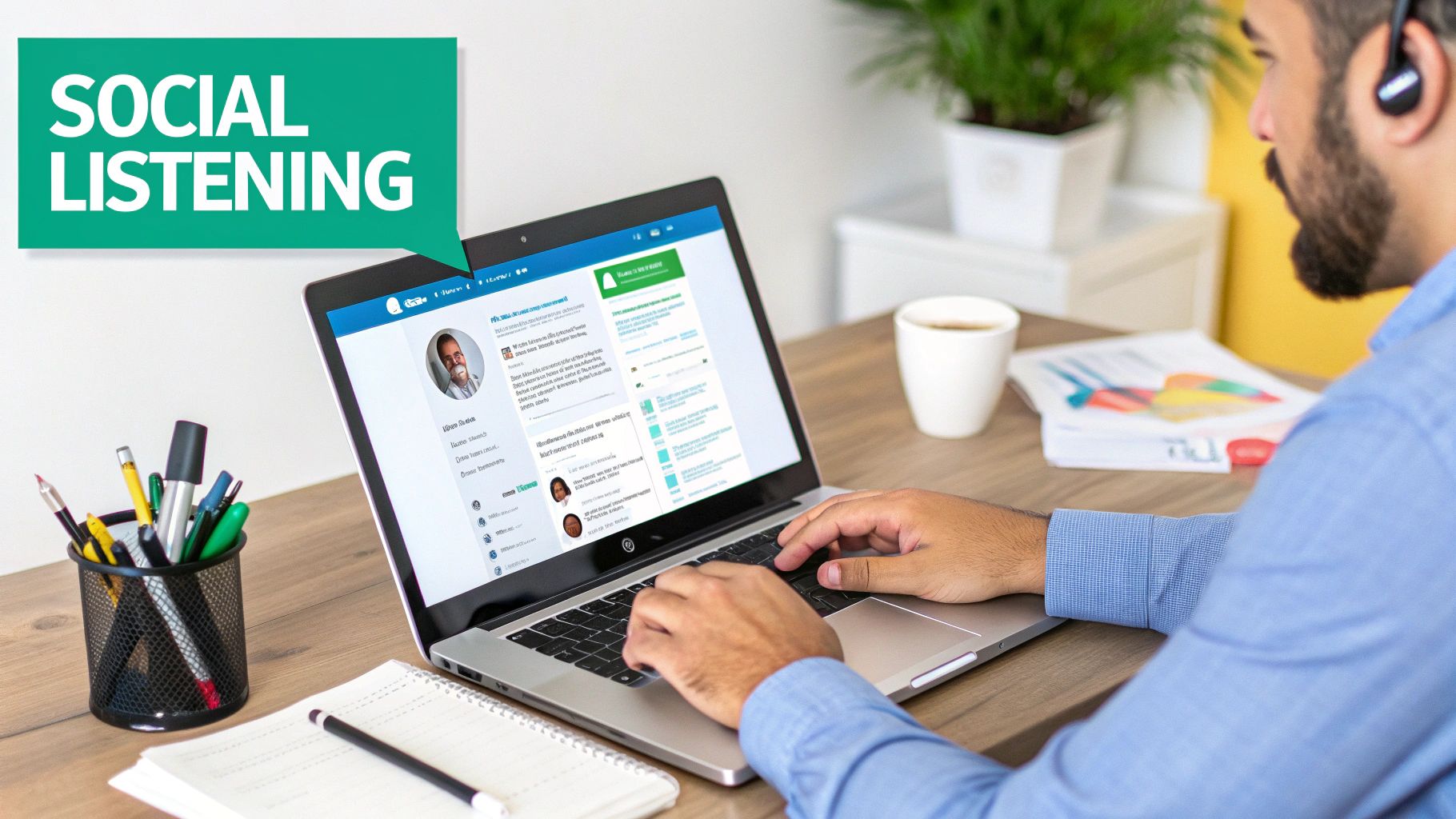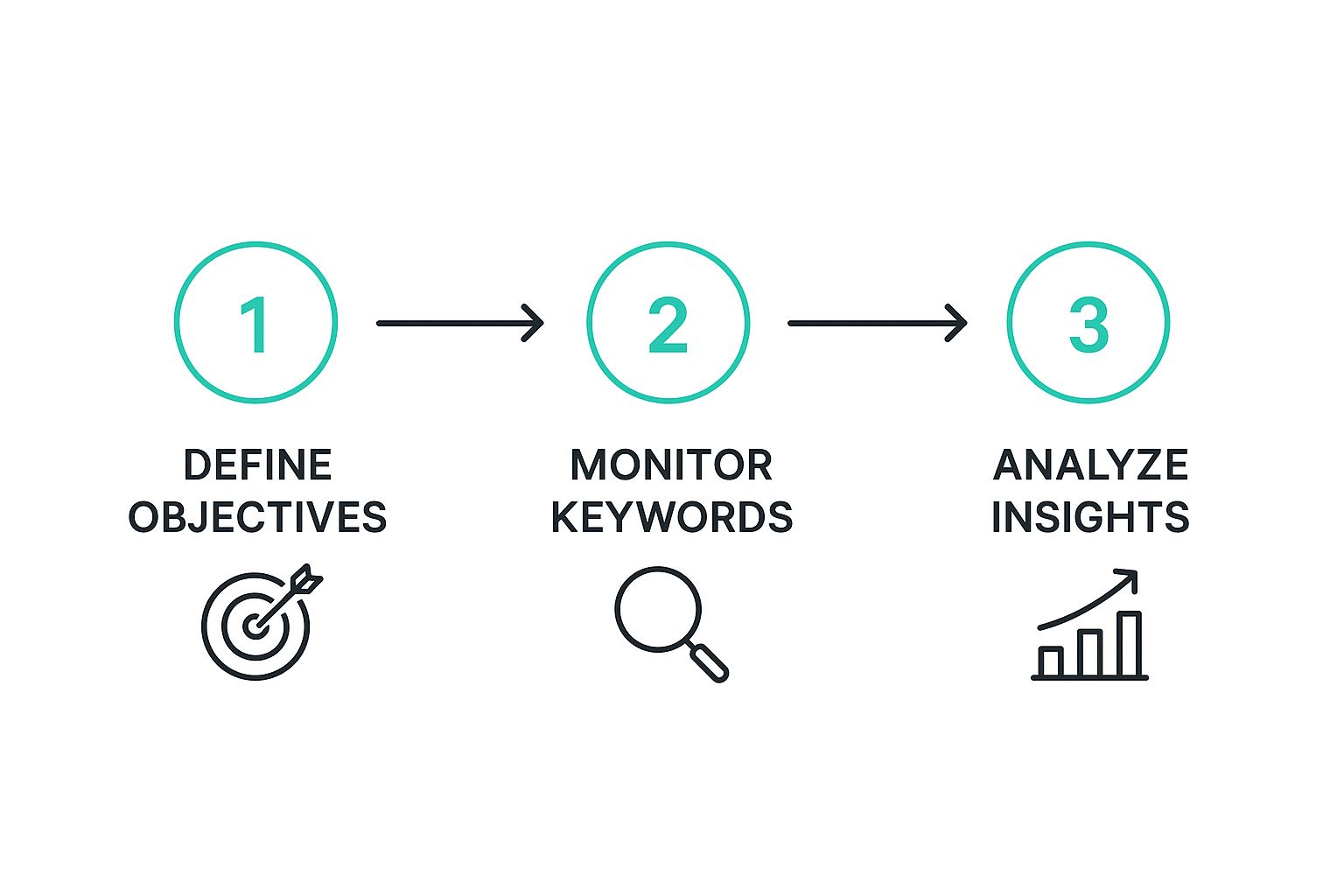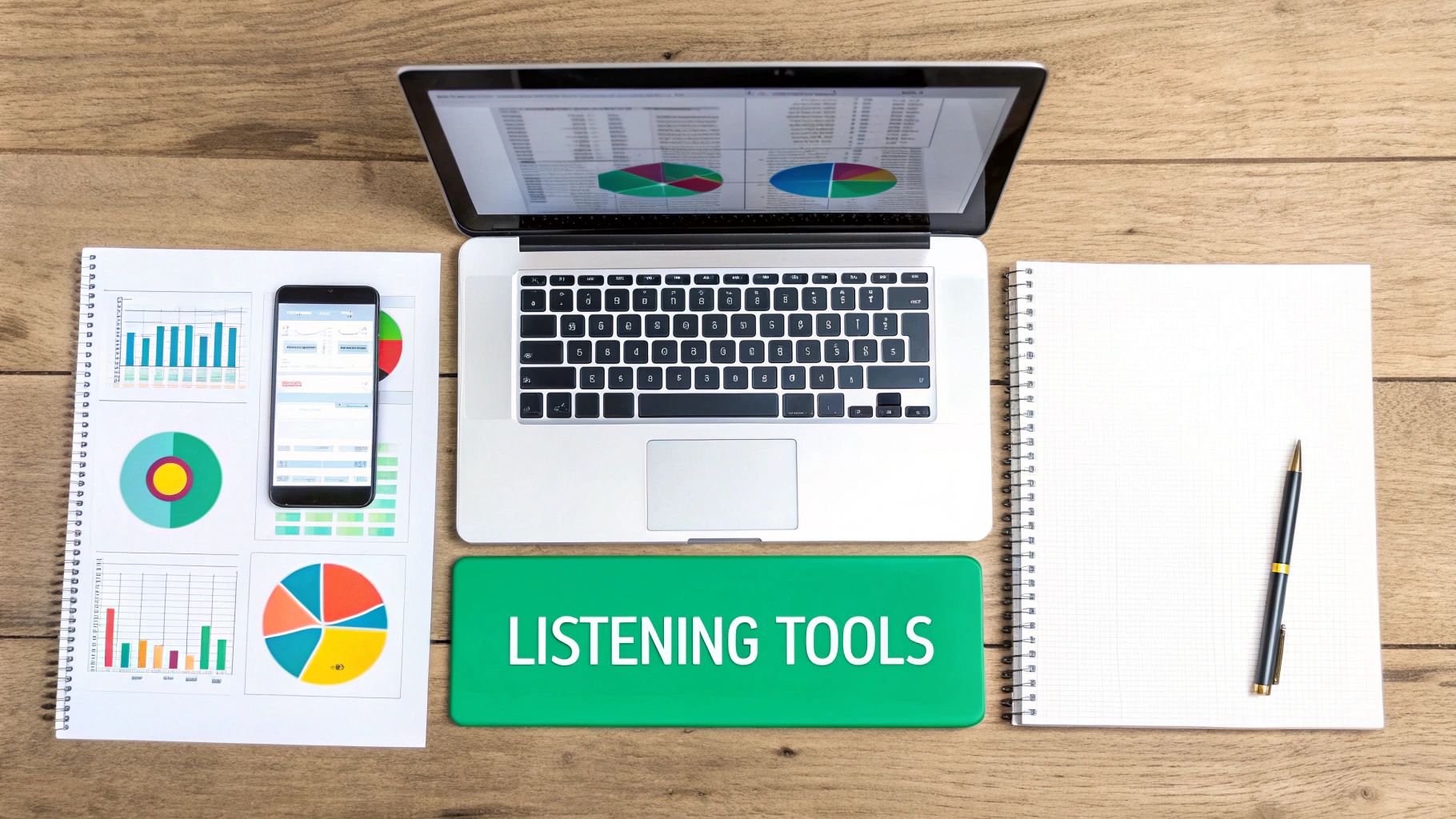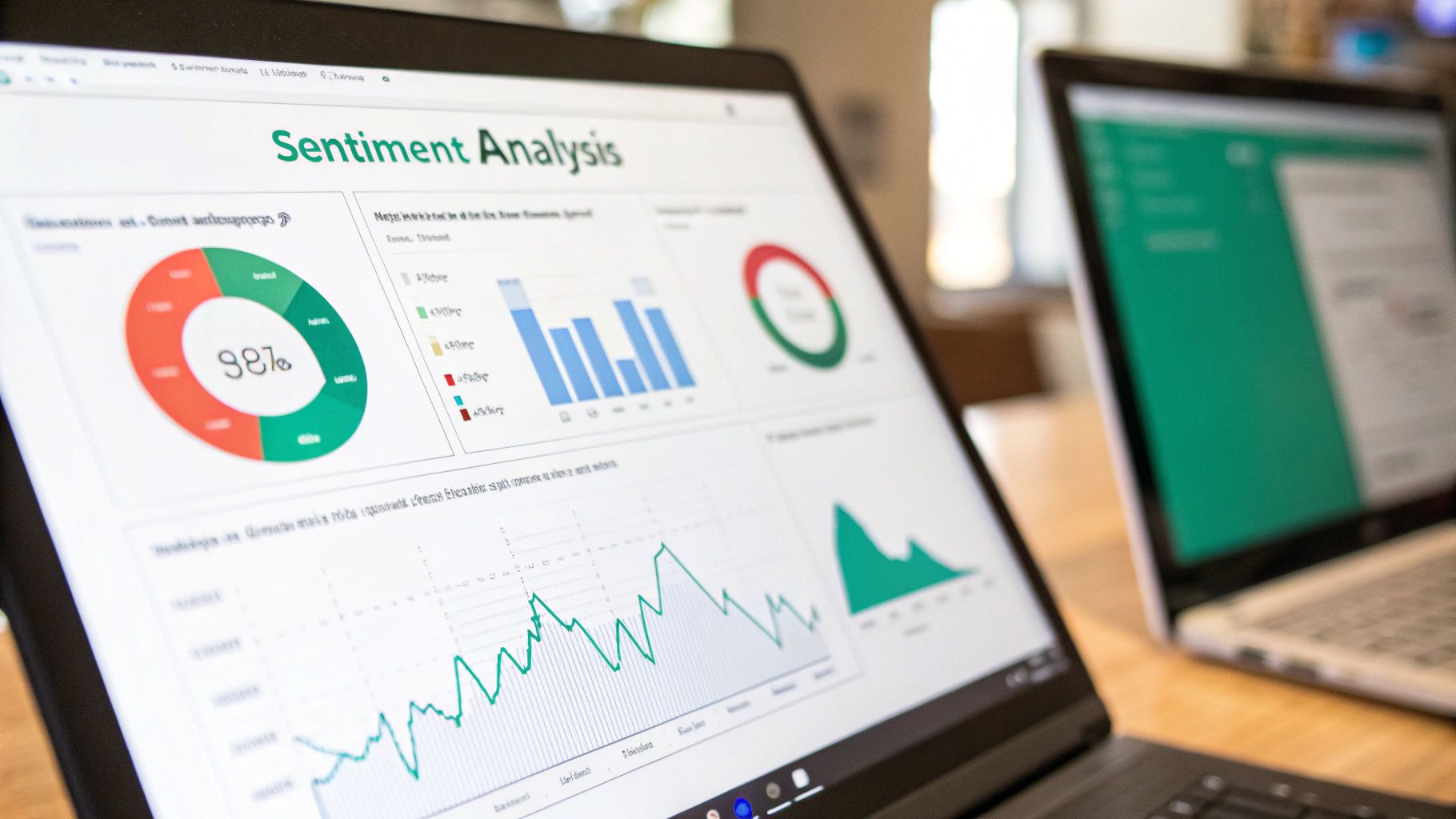Mastering Social Listening on LinkedIn
Think of social listening on LinkedIn as more than just tracking mentions. It's the art of tuning into the public conversations happening across the platform to pull out real, actionable insights. You're keeping an eye on what people are saying about your brand, your competitors, and the industry as a whole. This transforms LinkedIn from a place you just post updates to a powerful source of business intelligence.
Why LinkedIn Is Your B2B Intelligence Hub
Let's reframe how you see LinkedIn. It’s no longer just a digital resume and networking site—it's a goldmine of real-time business intelligence. What makes it so special is its uniquely professional context, turning it into the most valuable platform for B2B insights.

The conversations happening here aren't about vacation photos or weekend plans. They're about industry pain points, product recommendations, and strategic decisions. Tapping into these discussions is the key to truly understanding the market's pulse.
The Professional Context Matters
Unlike other social platforms, LinkedIn's user base is there for professional reasons. This creates a high-signal, low-noise environment where discussions are directly tied to business challenges, industry innovations, and purchase decisions. That professional focus means the insights you gather are often more direct and immediately useful for your B2B strategy.
By 2025, LinkedIn had cemented its status as the top platform for B2B marketing, growing to over 1.2 billion members globally. With around 1.77 billion monthly visits in February 2025 alone, the platform isn't just massive; it's incredibly active, making it fertile ground for listening. You can get a closer look at these numbers in Sprout Social's deep dive into LinkedIn statistics.
Uncovering Actionable Business Intelligence
Effective social listening on LinkedIn lets you move beyond just watching from the sidelines and into active intelligence gathering. You can monitor your brand's health, dissect what your competitors are up to, and spot emerging market trends before they hit the mainstream.
By listening to the authentic conversations happening every day, you gain unfiltered access to your audience's needs, frustrations, and desires. This is the raw material for smarter marketing, better products, and stronger customer relationships.
For instance, tracking the chatter around a competitor’s new product launch can reveal customer complaints that point to a gap in the market—a gap your company could fill. This is a core part of effective brand management. Our guide on social media reputation monitoring explores more strategies for protecting and building your brand's image online.
When you get this right, LinkedIn stops being just another content channel and becomes your company's most powerful strategic listening post. The key is simply knowing where to look and what to listen for.
Building Your Listening Framework from Scratch
A solid listening strategy isn't something you just stumble into; it’s built with purpose. Before you even think about tracking keywords or jumping into conversations, you need to lay the groundwork. It all starts with setting clear, measurable goals for what you want to achieve on LinkedIn.
What’s the endgame here? Your objectives will shape every single move you make. A sales team trying to generate leads will be listening for completely different signals than a PR team managing brand reputation.
Defining Your Listening Objectives
Think of your goals as your North Star. Without them, you're just collecting random data and noise. The best way to start is by asking what a “win” looks like for your team, then working backward to figure out which conversations will lead you there.
Most listening goals fall into a few common buckets:
- Lead Generation: Pinpointing professionals who are openly talking about problems your product solves or straight-up asking for recommendations.
- Competitor Intelligence: Keeping tabs on what your competitors are posting, how people are reacting, and even what their own employees are saying online.
- Brand Reputation Management: Tracking every mention of your company, products, and key executives to stay on top of public sentiment and engage where it counts.
- Content & Product Research: Digging into customer pain points, common questions, and industry chatter to get ideas for your next blog post or product update.
This simple flow shows how your objectives are the engine for your entire listening strategy.

As you can see, it's a cycle. Your goals determine what you monitor, which feeds into your analysis, which in turn helps you refine your goals over time. It’s a continuous loop of improvement.
Selecting the Right Keywords to Monitor
Once your goals are locked in, it’s time to build out your keyword list. And I mean really build it out. Don't just stop at your brand name. A truly comprehensive listening strategy casts a much wider net to catch conversations happening at every stage of the customer journey.
Your keyword list shouldn't be static; it needs to be dynamic and layered. For instance, a project management software company might track several different categories.
To build a robust keyword list, you need to think in categories. This approach ensures you're not just listening for brand mentions but are also tapping into conversations about industry problems, competitor weaknesses, and direct buying signals.
| Essential Keyword Categories for LinkedIn Listening | ||
|---|---|---|
| Keyword Category | Description | Example Keywords |
| Brand Terms | Direct mentions of your company, products, key personnel, or branded hashtags. | "OurBrand," "OurProduct," "CEO's Name" |
| Competitor Terms | Mentions of your direct and indirect competitors, their products, or their executives. | "CompetitorA," "CompetitorB feature," "alternative to CompetitorA" |
| Pain Point Keywords | The specific problems, frustrations, and challenges your ideal customers face. | "missed deadlines," "team collaboration issues," "project tracking" |
| Buying Intent Phrases | Phrases people use when they are actively looking for a solution like yours. | "looking for a project management tool," "recommendations for PM software" |
| Industry Jargon | Niche terms, acronyms, and buzzwords used by professionals in your target market. | "Agile workflow," "Scrum master," "Gantt chart" |
By organizing your keywords this way, you create a powerful framework that captures the full spectrum of relevant conversations, giving you a huge advantage.
The most valuable insights often come from tracking customer problems, not just your brand name. People rarely name-drop a solution when describing a pain point, so listening for the problem itself puts you in the right place at the right time.
Mastering LinkedIn Search and Boolean Operators
Most people don’t realize just how powerful LinkedIn’s native search function can be, especially when you start using its filters and Boolean operators. These are the tools that let you slice through the noise and zero in on the exact discussions you're looking for.
Boolean operators are simple commands that help you create incredibly specific search queries.
- AND: Narrows your results. A search for
"project management" AND "software"will only show posts containing both terms. - OR: Broadens your results. A search for
"SaaS" OR "cloud software"will find posts that mention either term. - NOT: Excludes specific terms. A search for
"hiring" NOT "recruiting"helps you filter out irrelevant job posts. - Quotes (""): This is for finding an exact phrase. Searching for
"looking for recommendations"ensures you find that precise string of words.
When you start combining these operators with LinkedIn’s post filters—like Date Posted, Author Industry, or Author Company—you turn a basic search into a precision-guided tool. This is how you create a repeatable process for social listening on LinkedIn, making sure you consistently find the conversations that actually matter to your business.
Choosing the Right Tools for the Job
While you can get started with LinkedIn's built-in search features, dedicated tools are what really turn social listening from a manual chore into a strategic weapon. Relying only on native search is like trying to build a house with just a hammer—you might get a few things done, but you’re missing the efficiency and precision of a full toolkit.

The real power of specialized software isn't just tracking mentions. It’s about putting the whole collection process on autopilot, analyzing sentiment at scale, and plugging those insights directly into your workflow. This frees you up to focus on what actually matters: engaging with prospects and understanding your market.
Native Features vs. Third-Party Platforms
LinkedIn’s own tools, like the "Mentions" tab and its advanced search filters, give you a solid foundation. You can definitely track competitors and specific keywords manually. But that approach has its limits. It's a huge time sink and offers zero deeper analytics, like sentiment analysis or trend tracking.
This is where third-party platforms come in. LinkedIn's API is notoriously strict, so no tool can scrape every single conversation on the platform. However, authorized tools can still track public brand mentions, keep tabs on competitor pages, and analyze engagement on your own content far more efficiently.
Here’s a quick breakdown:
| Feature | LinkedIn Native Tools | Third-Party Listening Tools |
|---|---|---|
| Mention Tracking | Manual; limited to direct tags in the Mentions tab. | Automated tracking of public mentions of your brand. |
| Sentiment Analysis | Not available. You have to gauge sentiment by hand. | Automated sentiment scoring (positive, neutral, negative). |
| Reporting | Basic analytics on your own page performance. | Customizable, automated reports and performance dashboards. |
| Workflow | Requires daily manual searches and data crunching. | Centralized dashboard for multiple platforms; real-time alerts. |
A dedicated tool basically puts your manual search process on autopilot. It gathers the data for you, so you can spend your time on analysis and action.
Making the Right Choice for Your Team
Picking the best tool comes down to your specific goals. You need something that fits your budget, your team's size, and what you’re actually trying to accomplish with social listening on LinkedIn.
Before you invest, think about these key factors:
- Your Main Goal: Is it lead generation, competitive intelligence, or brand reputation management? Different tools are built for different jobs. For example, platforms designed for sales will be much better at identifying buying signals.
- Integration: How easily does the tool plug into your existing tech stack? Look for integrations with your CRM or team communication apps like Slack. You want insights delivered directly to the people who need them.
- Scalability: Will this tool grow with you? Check the limits on user seats, the number of keywords you can track, and the volume of mentions it can handle as your business gets bigger.
The right tool doesn't just collect data; it delivers actionable insights. If a platform is only showing you what was said without helping you understand why it matters or what to do next, it's not the right fit.
Ultimately, you're looking for a solution that helps turn conversations into opportunities. Whether that means flagging high-intent prospects or gathering customer feedback, the right software makes the whole process faster and way more effective. If finding new customers is your top priority, our beginner’s guide to B2B lead generation might give you some ideas for refining that strategy. https://intently.ai/blog/beginners-guide-to-b2b-lead-generation
Turning Raw Data Into Real Opportunities
Collecting insights is only half the battle. Acting on them is where you win. A feed full of mentions and keyword alerts is just noise until you build a system to turn that raw data into measurable business outcomes. The real magic of social listening on LinkedIn happens when you have a clear playbook for different scenarios.
Imagine a prospect posts about a problem your product solves. What happens next? A well-defined process ensures your sales team gets a real-time alert, equipping them to engage thoughtfully and offer genuine value instead of a generic sales pitch. This is how you shift from passively monitoring to proactively engaging.
This proactive approach is incredibly powerful on LinkedIn. The platform's dominance in B2B lead generation is undeniable, with 40% of B2B marketers in 2025 ranking it as their most effective channel for high-quality leads. It's easy to see why—LinkedIn accounts for a staggering 80% of all B2B leads from social media, and marketers often see conversion rates double compared to other platforms. You can dig into more data on how to generate leads with LinkedIn on sopro.io.
From Listening to Leading Conversations
Turning data into opportunities means you need structured workflows. Your team needs to know exactly what to do when your listening tools flag a key conversation. The answer is simple, repeatable playbooks for common situations.
Here are a few real-world examples to bring this to life:
- The "Pain Point" Playbook: Someone posts a frustration that your product addresses. Your goal isn't to sell immediately. Instead, a team member should jump in with helpful advice, share a relevant resource, or connect them with an expert. This builds trust and positions you as the authority.
- The "Competitor Mention" Playbook: A prospect mentions they are evaluating a competitor. This is a golden opportunity. Your team can slide into their DMs with a comparison guide or highlight a key differentiator that solves a common complaint about that competitor.
- The "Content Gap" Playbook: You notice a recurring question in your industry that no one is answering well. That insight goes straight to your marketing team, who can then create a definitive blog post, webinar, or infographic addressing that exact topic.
The most successful teams don't just react to individual posts. They analyze trends over time to refine their value proposition, identify content gaps, and even inform product development. A single comment, spotted through smart listening, can become your next big client or strategic partnership.
By setting up these engagement workflows, you build a bridge between insight and action. This system ensures no opportunity slips through the cracks, allowing you to consistently turn LinkedIn conversations into tangible business results. It’s how you move from just listening to actively shaping the conversation in your market.
Advanced Tactics for Deeper Engagement
Alright, once you've got the basics down, it's time to move beyond simple monitoring. This is where you shift from just passively listening to actively participating in a smart, data-informed way. Your social listening on LinkedIn becomes less of a data collection exercise and more of a strategic weapon.
Instead of just logging mentions, you start using those insights to fuel a content strategy that hits on the exact conversations you're seeing.

This means you're creating posts, articles, and videos that answer the precise questions and solve the specific pain points bubbling up in your industry. When you consistently show up with valuable answers to real-time discussions, people stop seeing you as just another brand and start seeing you as a go-to resource.
The format you choose here really matters. While standard LinkedIn posts get a 2.8% engagement rate on average, that number can skyrocket with different media. For example, video content typically gets five times more engagement than text posts, and live video? That can boost interaction by a staggering 24 times compared to pre-recorded stuff. If you want to dig into more numbers like these, SocialPilot has some great LinkedIn statistics.
Tap Into Niche Communities
Some of the most honest, unfiltered conversations on LinkedIn are happening off the main feed. Think niche LinkedIn Groups and Events—these are absolute goldmines for deep listening. You get direct access to concentrated communities of professionals talking about very specific topics.
Jumping into these spaces lets you:
- Identify Unmet Needs: You'll spot common frustrations or questions that your content—or even your product—can solve.
- Find New Keywords: Pay attention to the jargon and phrasing your audience uses. You can plug these right back into your social listening alerts.
- Build Authentic Connections: Genuinely participate in discussions. Build some rapport before you even think about making a sales pitch.
Identify and Nurture Influencer Relationships
As you listen, you’ll start to see the same influential voices pop up again and again in key industry chats. These are your thought leaders, analysts, and power users whose opinions actually move the needle. Don't just follow them—engage with them.
The goal isn't to get a quick shout-out. It’s about building genuine, mutually beneficial relationships over time. A thoughtful comment on their post today could lead to a strategic partnership or co-marketing opportunity tomorrow.
Start by adding real value to their discussions. Share their content with your own insightful take, or jump in to answer a question they pose to their network. By consistently showing up as a knowledgeable peer, you lay the groundwork for a powerful professional alliance. This is also a fantastic way to surface high-value contacts, a core part of any modern sales strategy. If you're curious how tech can accelerate this, it’s worth learning more about what is AI lead generation and how it ties into these efforts.
Have Questions About LinkedIn Listening? Let's Clear Them Up
Even with the best game plan, you're bound to hit a few snags when you first dive into social listening on LinkedIn. It’s a unique platform with its own set of rules, and what works on X or Reddit doesn't always translate.
Here are some of the most common questions I hear from teams, along with practical answers to get you back on track.
Can You Track Keywords That Don't Mention Your Brand?
Yes, you absolutely can, but this is where you run into one of LinkedIn's biggest quirks. Because of their strict API policies, you can't just plug general keywords into a third-party tool and have it automatically monitor the entire network for you. It's a bit of a walled garden.
So, what's the workaround? You have to get your hands dirty with LinkedIn’s own search bar. It’s surprisingly powerful if you know how to use it. By stringing together keywords with advanced filters like Date Posted, Author Industry, or even Author Company, you can manually surface recent posts and articles.
It’s definitely a hands-on approach, but it's the only reliable way to tap into those broader conversations that don't directly tag your company page.
How Should We Handle Negative Brand Mentions on LinkedIn?
Seeing criticism pop up in such a professional setting can be jarring, but the way you handle it is everything. The golden rule is to respond quickly, publicly, and professionally before taking the conversation private.
A simple public reply works wonders. Something like: "Thank you for bringing this to our attention. I'm sorry to hear about your experience and have sent you a direct message to learn more and help resolve this."
This single comment does three crucial things:
- It acknowledges the problem in public, showing everyone else that you're on top of things.
- It starts with empathy, which immediately helps de-escalate the tension.
- It moves the nitty-gritty details offline, stopping a public back-and-forth before it can start.
Whatever you do, don't just ignore negative feedback. A thoughtful response can turn a frustrated customer into a huge fan and shows prospects you’re a brand that cares. Leaving a negative comment unanswered lets that person's narrative control the story.
What Is the Best Way to Measure the ROI of LinkedIn Listening?
Measuring the return on investment for your listening efforts on LinkedIn has to go deeper than just likes and comments. The real value comes from connecting your activities to actual business outcomes. Start by looking at the goals you set in the beginning.
Here are a few ways to frame it:
- For Sales-Focused ROI: How many qualified leads did you pull from conversations you jumped into? Of those, how many actually converted into paying customers? That’s a direct line from listening to revenue.
- For Brand Health ROI: Take a look at your brand sentiment over time. Are you seeing fewer negative mentions and more positive ones since you started engaging? That's a clear win.
- For Content Strategy ROI: Did you create a blog post based on a common pain point you overheard? Measure the engagement on that piece. If it got higher-than-average shares or comments, your listening is paying off.
By drawing a straight line from your listening activities to tangible results, you can easily show just how valuable social listening on LinkedIn is for the entire business.
Discover high-intent conversations and qualified leads you're missing on LinkedIn, Reddit, and X. Intently uses AI to monitor online channels 24/7, delivering real-time alerts when potential customers discuss problems your business can solve. Stop searching and start engaging by visiting https://intently.ai.
